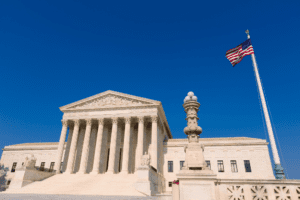 The dissent continued: Finally, the Court points out that New Jersey’s ban on public carriage applied only to certain people or to the concealed carriage of certain smaller firearms. Ante, at 39–40. But the Court’s refusal to credit the relevance of East New Jersey’s law on this basis raises a serious question about what, short of a “twin” or a “dead ringer,” qualifies as a relevant historical analogue. See ante, at 21 (majority opinion) (emphasis deleted).
The dissent continued: Finally, the Court points out that New Jersey’s ban on public carriage applied only to certain people or to the concealed carriage of certain smaller firearms. Ante, at 39–40. But the Court’s refusal to credit the relevance of East New Jersey’s law on this basis raises a serious question about what, short of a “twin” or a “dead ringer,” qualifies as a relevant historical analogue. See ante, at 21 (majority opinion) (emphasis deleted).
The tradition of regulations restricting public carriage of firearms, inherited from England and adopted by the Colonies, continued into the founding era. Virginia, for example, enacted a law in 1786 that, like the Statute of Northampton, prohibited any person from “going nor riding armed by night nor by day, in fairs or markets, or in other places, in terror of the Country.” 1786 Va. Acts, ch. 21. And, as the Court acknowledges, “public-carry restrictions proliferated” after the Second Amendment’s ratification five years later in 1791. Ante, at 42.
Just a year after that, North Carolina enacted a law whose language was lifted from the Statute of Northampton virtually verbatim (vestigial references to the King included). Collection of Statutes, pp. 60–61, ch. 3 (F. Martin ed. 1792). Other States passed similar laws in the late-18th and 19th centuries. See, e.g., 1795 Mass. Acts and Laws ch. 2, p. 436; 1801 Tenn. Acts pp. 260–261; 1821 Me. Laws p. 285; see also Charles, 60 Clev. St. L. Rev., at 40, n. 213 (collecting sources). The Court discounts these laws primarily because they were modeled on the Statute of Northampton, which it believes prohibited only public carriage with the intent to terrify. Ante, at 41. I have previously explained why I believe that preventing public terror was one reason that the Statute of Northampton prohibited public carriage, but not an element of the crime. See supra, at 37–39. And, consistent with that understanding, American regulations modeled on the Statute of Northampton appear to have been understood to set forth a broad prohibition on public carriage of firearms without any intent-to-terrify requirement. See Charles, 60 Clev. St. L. Rev., at 35, 37–41; J. Haywood, A Manual of the Laws of North-Carolina, pt. 2, p. 40 (3d ed.1814); J. Ewing, The Office and Duty of a Justice of the Peace 546 (1805).
Dissenting opinions often signal to States how they can undermine the majority opinion by relying on their own State Constitutions. That is more often the case when the U.S. Supreme Court limits our rights under the federal constitution. Here, the majority is expanding our Second Amendment rights. The dissent seems more focused rebutting the historical underpinnings of the majority opinion than it is on signaling to the states how they can still limit the public carriage of firearms without violating the binding majority opinion.
